Geographical regions of Turkey
The geographical regions of Turkey comprise seven regions (Turkish: bölge) which were originally defined at the country's First Geography Congress in 1941.[1] These seven regions are subdivided into twenty one sections (Turkish: bölüm), which are further split into numerous areas (Turkish: yöre) as defined by microclimate and bounded by local geographic formations.
| Regions of Turkey Türkiye'nin bölgeleri (Turkish) | |
|---|---|
| Category | Unitary state |
| Location | Turkish Republic |
| Number | 7 |
| Populations | 6,513,106 (Eastern Anatolia) – 26,650,405 (Marmara) |
| Areas | 59,176 km2 (22,848 sq mi) (Southeastern Anatolia Region) – 165,436 km2 (63,875 sq mi) (Eastern Anatolia Region) |
| Government |
|
| Subdivisions |
|
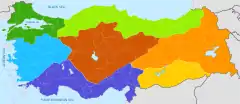
Map of the geographic regions, color-coded, with national (gray) and provincial borders (white).
List of geographical regions
- Marmara Region (dark green)
- Black Sea Region (light green)
- Aegean Region (blue)
- Mediterranean Region (purple)
- Central Anatolia Region (brown)
- Eastern Anatolia Region (orange)
- Southeastern Anatolia Region (yellow)
"Regions" as defined in this context are merely for geographic, demographic, and economic purposes, and do not refer to an administrative division.
Regions and subregions
| Region | Capital | Area (km2) | Provinces (Counties) | Population | Location |
|---|---|---|---|---|---|
| Aegean Region | Izmir | 85,000 | 8 | 10,477,153 | |
| Black Sea Region | Trabzon | 143,537 | 18 | 7,696,132 | |
| Central Anatolia Region | Ankara | 163,057 | 13 | 12,896,255 | |
| Eastern Anatolia Region | Van | 165,436 | 14 | 6,513,106 | |
| Marmara Region | Istanbul | 67,000 | 11 | 26,650,405 | |
| Mediterranean Region | Antalya | 122,927 | 8 | 10,584,506 | |
| Southeastern Anatolia Region | Sanliurfa | 59,176 | 9 | 8,576,391 | |
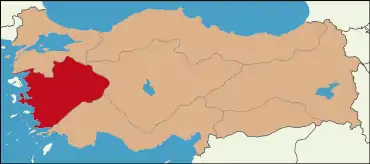
Aegean Region
- Aegean Region
- Aegean Section
- Edremit Area
- Bakirçay Area
- Gediz Area
- Izmir Area
- Küçük Menderes Area
- Büyük Menderes Area
- Mentese Area
- Inner Western Anatolia Section
- Aegean Section
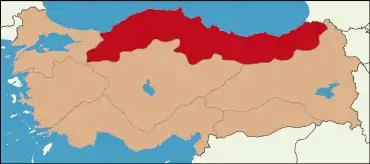
Blacksea Region
- Black Sea Region
- Western Black Sea Section
- Inner Black Sea Area
- Küre Mountains Area
- Central Black Sea Section
- Canik Mountains Area
- Inner Central Black Sea Area
- Eastern Black Sea Section
- Eastern Black Sea Coast Area
- Upper Kelkit - Çoruh Gully
- Western Black Sea Section
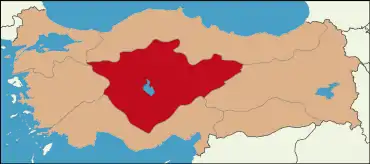
Central Anatolia Region
- Central Anatolia Region
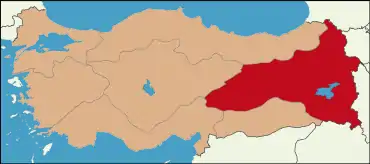
Eastern Anatolia Region
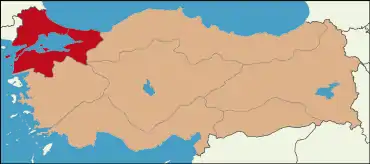
Marmara Region
- Marmara Region
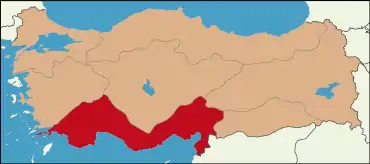
Mediterranean Region
- Mediterranean Region
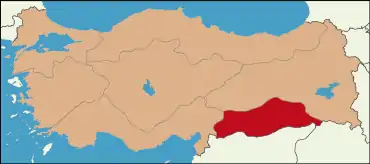
Southeastern Anatolia Region
- Southeastern Anatolia Region
- Middle Euphrates Section
- Tigris Section
- Diyarbakir Area
- Mardin - Midyat Area
Distinctions of the regions
The Aegean Region has:
- the longest coastline

Artvin Province, East of the Blacksea Region
The Black Sea Region has:
- highest annual precipitation
- largest forest area
- fewest sunshine hours
- most landslides

Cappadoccia and famous fairy chimneys rock formation
The Central Anatolia Region has:
- lowest annual precipitation,
- most erosion
The Eastern Anatolia Region has:
- largest area
- highest altitude
- lowest annual temperature
- coldest winters
- highest temperature difference between seasons
- most volcanic activity
- smallest population
- highest mineral resources

İstanbul is crowded city of the Marmara Region and all Turkey
The Marmara Region has:
- smallest area
- lowest altitude
- most climate diversity
- highest energy consumption,
- coolest summers,
- largest population

Mediterranean Region is well-known sea-tourism zone because of own climate
The Mediterranean Region has:
- highest annual temperature
- mildest winters
- wettest winters,
- most greenhouse farming
The Southeastern Anatolia Region has:
- hottest summers
- driest summers
- smallest forest area
- most sunshine hours
Population by region
| Region | Population |
|---|---|
| Marmara | 26,650,405 |
| Central Anatolia | 12.896.255 |
| Mediterranean | 10.584.506 |
| Aegean | 10.477.153 |
| Southeastern Anatolia | 8.576.391 |
| Black Sea | 7.696.132 |
| Eastern Anatolia | 6.513.106 |
Sources
- Ali Yiğit, "Geçmişten Günümüze Türkiye'yi Bölgelere Ayıran Çalışmalar ve Yapılması Gerekenler", Ankara Üniversitesi Türkiye Coğrafyası Araştırma ve Uygulama Merkezi, IV. Ulural Coğrafya Sempozyumu, "Avrupa Birliği Sürecindeki Türkiye'de Bölgesel Farklılıklar", pp. 34–35. Archived 2012-03-31 at the Wayback Machine
- "Türkiye'nin Nüfus Haritası". www.icisleri.gov.tr. Retrieved 2020-08-19.
This article is issued from Wikipedia. The text is licensed under Creative Commons - Attribution - Sharealike. Additional terms may apply for the media files.